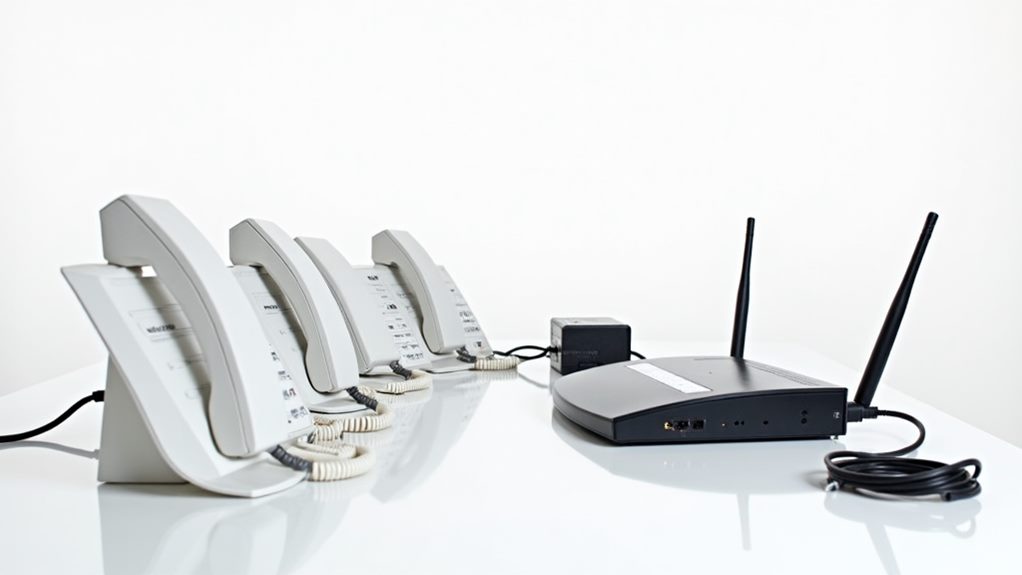To set up VoIP for your small business, start by evaluating your communication needs and daily call volumes. You'll need a reliable broadband internet connection maintaining at least 90 kbps per call, with low ping and jitter rates. Select compatible VoIP equipment, including IP phones or softphones, and guarantee your network infrastructure can handle VoIP traffic through proper QoS settings. Choose a VoIP provider that aligns with your business requirements, comparing features, pricing, and scalability options. Finally, implement thorough staff training on the new system's features and functionality. The success of your VoIP implementation depends on following these technical steps with precision.
Assessing Business Communication Requirements

Before implementing a VoIP system for your small business, conducting a thorough assessment of your communication requirements will guarantee a successful deployment. Start by analyzing your current phone system usage, tracking the number of users and monitoring your daily volume of calls. This data will help you determine the necessary capacity for your VoIP setup and ascertain seamless communication across your organization.
Additionally, consider factors like reliability and uptime which are vital for maintaining uninterrupted service. Next, evaluate your call patterns by examining the ratio of inbound vs. outbound calls, which will guide you in selecting the most relevant VoIP features for your needs.
Consider your team's device preferences, noting whether they primarily use mobile or landline phones. This information will help you choose a VoIP system that aligns with their working habits.
You'll also need to identify specialized features required by different departments – for instance, your sales team might need call recording, while customer support may require advanced call routing capabilities.
Network Infrastructure and Connectivity
When implementing VoIP for your small business, a robust network infrastructure serves as the foundation for reliable voice communications. Your broadband internet connection must maintain minimum upload and download speeds of 90 kbps per call to guarantee peak VoIP performance. To achieve this, consider investing in high-performance options like the best VoIP router options available in Australia.
Run regular speed tests to monitor essential metrics, keeping ping under 150 ms and jitter below 30 ms for consistent call quality.
To maximize your VoIP system's reliability, connect your devices using Ethernet cables rather than wireless connections. This wired setup provides enhanced stability, particularly when your office experiences high call volumes.
You'll also want to configure Quality of Service (QoS) settings on your network routers to prioritize VoIP traffic over other data transmissions, reducing latency and maintaining clear audio during calls.
If your business handles numerous simultaneous calls, consider implementing a dedicated network for your VoIP systems. This separation prevents other internet activities from impacting your voice communications and guarantees consistent performance across all devices.
Selecting VoIP Equipment

With your network infrastructure in place, the right VoIP equipment selection will determine your communication system's effectiveness. Your primary focus should be on ensuring compatibility between your chosen VoIP provider and the hardware components while maintaining flexibility for your team's diverse needs.
Additionally, evaluating the VoIP phone compatibility and types will further guide your decision-making process in selecting the most appropriate hardware.
Consider these essential VoIP equipment options for your small business setup:
- IP phones with RJ-45 ethernet ports for wired connections, preferably supporting Power over Ethernet (PoE) to simplify installation and reduce cable clutter.
- Softphones for team members who need mobility, allowing them to make calls directly from their computers or mobile devices without additional hardware costs.
- Analog Telephone Adapters (ATAs) if you're shifting from traditional phone systems, enabling you to integrate existing analog phones into your VoIP network.
- Wireless VoIP headsets for team members who require movement flexibility within the office space.
When evaluating equipment options, verify that each device supports your required features, including call forwarding and conferencing capabilities.
The key is selecting hardware that aligns with your business communication needs while ensuring seamless integration with your VoIP provider's platform. This strategic approach to equipment selection will create a unified and efficient communication system.
Provider Evaluation and Setup
Success in implementing VoIP relies heavily on selecting the right service provider and executing a proper setup process. When evaluating VoIP providers, you'll need to analyze their core features, confirming they align with your business needs. Focus on essential capabilities like call routing, auto-attendant functionality, and compatibility with your existing software infrastructure.
Compare pricing models across different providers, examining both monthly subscription costs and fees for advanced features. You'll want to calculate potential savings against traditional phone systems to justify your investment.
During your provider evaluation, prioritize those offering robust customer support and proven service reliability, as these factors directly impact your daily operations.
If you're planning to keep your current phone numbers, verify that your chosen provider supports number porting before making a commitment. This step prevents communication disruptions during the changeover.
Additionally, assess the provider's scalability options – you'll need the flexibility to add or remove lines as your business grows. Look for providers who offer straightforward scaling processes without complex contract modifications. This approach guarantees your VoIP system can adapt to your evolving business requirements while maintaining cost-effectiveness and operational efficiency.
Staff Training and Deployment

Implementing effective staff training represents an essential step in deploying your VoIP system successfully. To maximize productivity and guarantee smooth adoption, develop thorough training materials that cover all essential VoIP features and functionality.
Your training program should include hands-on practice sessions where employees can interact directly with the system, learning to handle basic troubleshooting and daily operations.
Key components for successful staff training and deployment:
- Organize structured training sessions focusing on core VoIP features like call routing, conferencing, and voicemail-to-email integration.
- Create user-friendly guides and documentation that staff can reference when learning new system functionalities.
- Schedule hands-on practice sessions to build confidence in system operation and basic troubleshooting.
- Establish ongoing support channels, including helpdesk access and advanced feature tutorials.
Monitor user feedback and system usage patterns post-deployment to identify areas requiring additional training.
This data-driven approach helps you adjust your training strategy and guarantee your team fully utilizes the VoIP system's capabilities.
Final Thoughts
Your VoIP implementation is like building a digital bridge for your business communications. You'll need to maintain this infrastructure through regular network assessments, equipment updates, and ongoing staff training. Monitor call quality metrics as your canary in the coal mine for system health. When properly configured, your VoIP system will function as a seamless communications backbone, scaling with your business growth while reducing traditional telephony costs.

